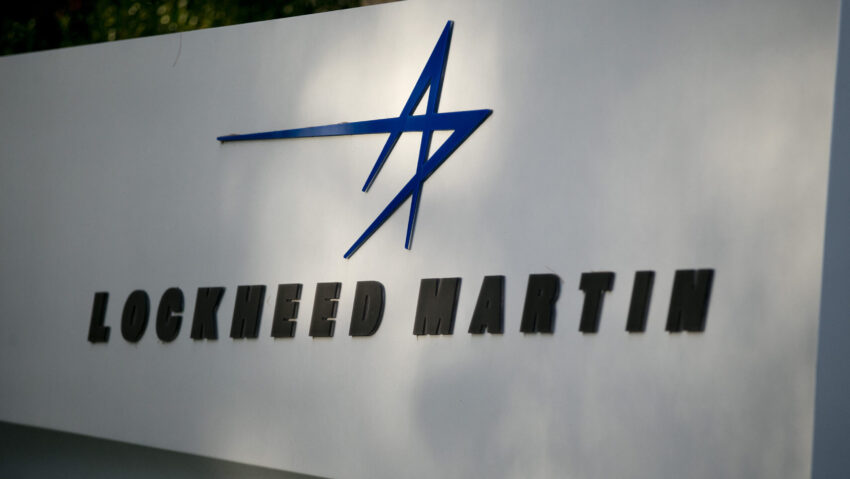A sign for Lockheed Martin Corp. stands outside the company’s headquarters in Bethesda, Maryland, U.S., on Friday, Nov. 16, 2012. (Andrew Harrer/Bloomberg via Getty Images)
WASHINGTON — Lockheed Martin booked $1.6 billion in losses and $169 million for other charges during the second quarter of 2025 due to continued challenges on a classified aircraft program, the loss of the Air Force’s sixth generation fighter program and the potential restructure of two international helicopter programs, the company announced today.
Throughout an earnings call this morning, Lockheed CEO Jim Taiclet attempted to assure Wall Street that the company had a clear view of potential risks and had done everything in its power to drive down the chance of future losses, with analysts repeatedly questioning executives about why investors should feel confident in Lockheed’s assessments.
“We take these financial charges very seriously and are redoubling our focus on program management performance under existing contracts across the company, while also ensuring that all future contracts more robustly assess and account for future programs and technical risks,” Taiclet said in the call.
The company incurred the largest loss — worth $950 million — on the classified fixed-priced aeronautics program, which has been the source of previous charges for Lockheed.
In a news release, Lockheed attributed the reach-forward losses on the aeronautics project to continued design, integration, and test challenges that “had a greater impact on schedule and costs than previously estimated.” The company completed a comprehensive review of the program in the second quarter and made “significant changes to its processes and testing approach,” which in turn resulted in additional cost and schedule delays.
Taiclet said changes to the program included assigning experts from across the company to improve its performance under a new risk identification and corrective action plan.
“This is a highly classified program that can only be described as [a] game-changing capability for our joint US and international customers, and therefore it is critical that it be successfully fielded,” he said. “With our enhanced oversight of this program and rapid incorporation of lessons learned, we expect to continue to reduce risk over the next few years as we move through the key milestones of this very advanced system.”
Lockheed previously booked a $555 million loss on the same classified aerospace program in the fourth quarter of 2024. At the time, the company cited a recent review of the program, which had found that it would have to spend more money on engineering and integration activities in order to meet upcoming milestones.
Asked about the latest review of the program and why it was different than the one that occurred in late 2024, Taiclet said it was undertaken by the company’s new Chief Financial Officer Evan Scott after challenges began to reemerge in early 2025. The more recent review dug deeper into the assumptions of the program, which were then rebaselined according to the company’s current level of performance and the number of years left on the fixed-price portion of the contract — a detail Taiclet could not share due to the program’s classification.
“Will there be opportunity to reduce that [potential loss]? We hope so,” Taiclet said. “Part of it is potential contract restructuring. The customer is aware of, and will become increasingly aware after today, the cost that this program is putting on the company, and I think they’re open to figuring out ways to make it more reasonable.”
Helo Losses And NGAD Charges
In addition to the classified aero losses, Lockheed also logged a $570 million loss on the Canadian Maritime Helicopter and a loss of $95 million on the Turkish Utility Helicopter due to the customers’ need to restructure both of those programs.
For the Turkish program, Taiclet said the company had reached a notional agreement that included “a change of scope of work due to the impacts of US government sanctions on Turkish entities and persons involved in that program.”
Meanwhile, negotiations with the Canadian government continue over its maritime helicopter program and potential changes in contract terms, with Taiclet saying that Lockheed remains focused on “providing additional mission capabilities, enhancing logistical support and extending the fleet’s life.”
Separate from those losses, Lockheed also recognized a $66 million charge “for the write-off of fixed assets” associated with the Air Force’s Next Generation Air Dominance fighter competition, which it lost to Boeing in March. A separate $103 million charge was recorded to account for “uncertain tax positions” that resulted from a new changes to IRS approved accounting methods.
At mid-day, Lockheed shares had sank about 8.5 percent.
Robert Stallard, an analyst with Vertical Research Partners, said there was only “limited comfort” that further losses won’t occur on these programs into the future.
“While Lockheed management detailed a number of reasons for why these charges had been taken in 2Q, they gave little assurance that the related risk is now behind us,” he wrote in an email to investors. “The biggest worry is the classified program in Aeronautics, which made up the bulk of the charges in the quarter. Lockheed is unable to say how long the program still has to run due to its secretive nature, and can’t also give any details on what issues the [Lockheed experimental lab] Skunk Works is dealing with.”
Click this link for the original source of this article.
Author: Valerie Insinna
This content is courtesy of, and owned and copyrighted by, https://breakingdefense.com and its author. This content is made available by use of the public RSS feed offered by the host site and is used for educational purposes only. If you are the author or represent the host site and would like this content removed now and in the future, please contact USSANews.com using the email address in the Contact page found in the website menu.








